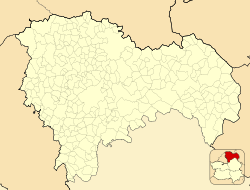This article needs additional citations for verification .(April 2024) |
Espinosa de Henares, Spain | |
|---|---|
 | |
| Coordinates: 40°54′20″N3°04′14″W / 40.90556°N 3.07056°W | |
| Country | |
| Autonomous community | Castile-La Mancha |
| Province | Guadalajara |
| Municipality | Espinosa de Henares |
| Area | |
• Total | 39 km2 (15 sq mi) |
| Elevation | 761 m (2,497 ft) |
| Population (2024-01-01) [1] | |
• Total | 690 |
| • Density | 18/km2 (46/sq mi) |
| Time zone | UTC+1 (CET) |
| • Summer (DST) | UTC+2 (CEST) |
Espinosa de Henares is a municipality located in the province of Guadalajara, Castile-La Mancha, Spain. According to the 2004 census (INE), the municipality has a population of 631 inhabitants.




